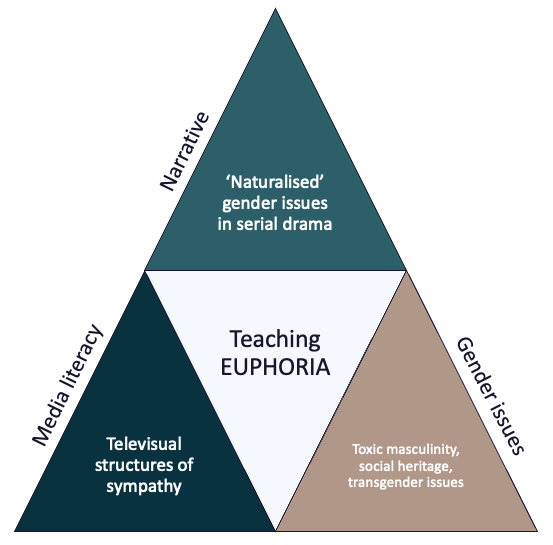Euphoria and representations of toxic masculinity
The nature of a sequence #1
By Kim Toft Hansen, 16 February 2024
“Well, I also said this to some of my friends when we watched Euphoria: ‘She’s transgender, isn’t she? And they were like: ‘Is she?’ And I think it’s cool that it’s something you see at first, but that a character is created without the person being lesbian, homosexual, gay, yeah.”
Anonymised respondent in Danish focus group interview
The American HBO series Euphoria (2019-) has been recognized for its unforced narrative about transgender. The respondent above from a Danish focus group interview on young high school series consumption is representative for how the series is acknowledged for its naturalised incorporation of the transgendered character Jules. Even though the series most important topic is drug abuse, its attention towards gender issues is significantly important too. This blog entry displays how a central sequence from the series, Nate’s breakdown scene (S1:E8), may provide high school teachers with material to teach complex seriality and gender issues altogether.
The sequence takes place deep into the first season when many characters have been established. We now know about Rue’s drug abuse, her friendship with the transgendered Jules, her relations to friends in school, including the venomous relationship between the couple Maddy and Nate. At this stage, we have established Nate as the captain of the football team and a dominant male leader, while we – as a narrative subplot – have also seen Nate’s father’s troublesome and undisclosed interest in sexual relations to youngsters. In this case, we have from the start instituted his abusive affiliation with Jules, a relationship that he videorecords with hidden cameras. Some of these videos now travel around without his father’s knowing, potentially exposing his illegal and amoral exploitation of Jules.

Image 1: The motel scene from the pilot episode of Euphoria (S1:E1) that sets off the unbalanced relationship between Nate’s father Cal and the transgendered Jules.
When we enter the central scene, Rue lets Nate in on how the knowledge about his father may potentially ruin both Nate and his father. Nate exposes a range of controlling and derogative ‘complements’ about Rue’s beauty, and the scene then cuts to Nate on the football field – a game, which he alone wins for his team by running a touchdown. When he wins the game, the camera cuts to Maddy, his girlfriend, and his father, both characters not sharing the joy about the win with Nate and the rest of the stadium. These are basic, condensed hints towards the problematic relationship between, first, Nate and Maddy, and then of course Nate and his father.
The climax of the sequence appears when Nate’s father confronts Nate with his inability to control his team, exposing Nate’s weaknesses, symbolically stressed by Nate being naked in the scene. Nate tries to confront his father, but the father succeeds in physically overpowering Nate, which results in Nate’s complete breakdown. Confounded, the father spurts the scene and hides himself in his office. As he sits down in his office chair, he lets his eyes run towards the desk drawer in which he keeps the video recordings of the abuse of youngsters. On the one hand, this indicates his father abuse as a misunderstood release for his undisclosed sexual orientation. On the other hand, the scene cuts to a girl who completes copying a compact disc, indicating that the videos are out there, shared, and that Nate’s father is about to fall.
Pedagogical use of Euphoria in high school teaching
Since GEMINI works towards developing teaching material for European high schools and beyond, this specific sequence from Euphoria (and the series in general) displays several relevant issues to debate in classroom teaching, including perspectives on media literacy and gender issues.

Image 2: Teaching Euphoria, presents opportunities for high school teachers to teach serial narrative comprehension, structures of sympathy, and toxic masculinity to high school students.
Firstly, the sequence provides an opportunity to address gender issues from what many high school students in the Danish focus group interviews regard as unforced, naturalised narratives about gender. High school students appear to disapprove forced ways to tell stories about gender relationships and sexuality – and Euphoria is among the series that appear accepted for its portrayal of especially the characterisation of the transgendered Jules. In the end, this opens the narrative for the target audience and presents an opportunity to teach complex seriality in relation to a series that appears ‘liked’.
Secondly, the specific scene described above is also a suitable example of how complex seriality may tweak the structures of sympathy in a drama. Mostly, the viewers are invited to dislike Nate because he is incredibly controlling and abusive towards his surroundings and especially his girlfriend Maddy. However, when we are exposed to how his father is likewise controlling and vicious – and essentially sadistic – towards Nate, viewers may acquire a more sympathetic understanding of where Nate’s nature comes from. Besides showcasing the complexities of complex narrative storytelling, the series may enhance students’ ideas about how characters may develop throughout a long serial narrative. The sequence does not present justifications for Nate’s behaviour, but it provides viewers with reasons for his nature.
Thirdly, the sequence illustrates – almost from a theoretical perspective – understandings of what has been termed ‘toxic masculinity’. As noted by Carol Harrington, “toxic masculinity spread from men’s movements to wider self-help, academic, and policy literature. This literature posited that emotionally distant father-son relationships produced “toxically” masculine men”, i.e. “men who lack adequate fathering pursue unrealistic cultural images of masculinity and feel a constant need to prove their manhood” (2021, 347). Harrington’s description of the origins of the term is an almost too fitting description of Nate’s character development in Euphoria, exposing a teaching opportunity to debate such conceptualisations in relation to a popular, acknowledged serial drama. This may include perspectives on how Nate pursues his “unrealistic cultural images of masculinity” through his endeavors on the football field.

Nate, alone in the football field, jabs his own shoulder in acknowledgement in Euphoria (S1:E8). Indicatively, the team which he is supposed to lead is missing around him.
The image of Nate after the game-winning touchdown, alone on the football field, with a confounded look on his face, is very indicative of the overall situation and his misunderstood comprehension of leadership and masculinity. A sense of masculine control that, through the narrative development, reverts to the situation around Jules and her gender identity and sexual orientation. Complexly, this five-minute sequence is a condensed account of gender matters and serial comprehension that may be unpacked with students in a high school teaching situation.
Watch the full sequence from Euphoria through the GEMINI Facebook page.
Literature
Harrington, C. (2021). What is “Toxic Masculinity” and Why Does it Matter? Men and Masculinities, 24(2), 345-352. https://doi.org/10.1177/1097184X20943254.



